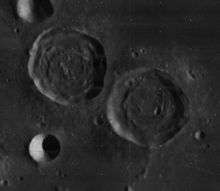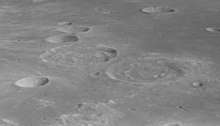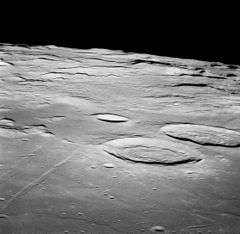Sabine (crater)
Sabine is a lunar impact crater that forms a nearly matching pair with Ritter to the northwest. The two rims are separated by a distance of only a couple of kilometers. To the west is the bowl-shaped crater Schmidt, and farther to the north are Manners and Arago. Its diameter is 30 km. It was named after Irish physicist and astronomer Edward Sabine.[1]


 Sabine (center right) and Ritter (right), from Apollo 11 | |
| Coordinates | 1.4°N 20.1°E |
|---|---|
| Diameter | 30 km |
| Depth | 1.3 km |
| Colongitude | 340° at sunrise |
| Eponym | Edward Sabine |
Description
The outer rim of this crater is roughly circular and relatively featureless. The interior floor has a pair of small craterlets and a central rise. There is a ridge at the western edge of the floor that is concentric with the inner wall.
About 85 km to the east-southeast is 'Statio Tranquillitatis' (Tranquility Base), the landing site of the Apollo 11 mission and the first human beings to step on the Moon.
Ranger 8 flew over Sabine prior to impact in Mare Tranquilitatis.
Both Sabine and Ritter were originally believed to be calderas rather than impact craters. In To A Rocky Moon, lunar geologist Don E. Wilhelms summarized: "They are identical twins in morphology and size (29-30 km). They lack radial rim ejecta and secondary craters despite their apparent youth. They are positioned at the presumably active edge of a mare. They are even aligned along graben, the Hypatia rilles. Most significant, they lack deep floors recognized since the days of Gilbert as diagnostic of impacts." However, after the Apollo landings were complete, it was realized that "all craters inside basins suffer enhanced isostatic uplift," because "the thin crust and greater heat inside basins lower the viscosity of the craters' substrate, allowing it to reach isostasy with its surroundings more quickly than can other craters."[2]
Satellite craters
By convention these features are identified on lunar maps by placing the letter on the side of the crater midpoint that is closest to Sabine.

| Sabine | Latitude | Longitude | Diameter |
|---|---|---|---|
| A | 1.3° N | 19.5° E | 4 km |
| C | 1.0° N | 23.0° E | 3 km |
The following craters have been renamed by the IAU, after the three astronauts of Apollo 11.[3]
References
- "Sabine (crater)". Gazetteer of Planetary Nomenclature. USGS Astrogeology Research Program.
- To a Rocky Moon: A Geologist's History of Lunar Exploration. Don E. Wilhelms, University of Arizona Press (1993). ISBN 978-0816510658
- Lunar Chart Series LAC-60 Julius Caesar, Lunar and Planetary Institute
- Andersson, L. E.; Whitaker, E. A. (1982). NASA Catalogue of Lunar Nomenclature. NASA RP-1097.CS1 maint: ref=harv (link)
- Bussey, B.; Spudis, P. (2004). The Clementine Atlas of the Moon. New York: Cambridge University Press. ISBN 978-0-521-81528-4.CS1 maint: ref=harv (link)
- Cocks, Elijah E.; Cocks, Josiah C. (1995). Who's Who on the Moon: A Biographical Dictionary of Lunar Nomenclature. Tudor Publishers. ISBN 978-0-936389-27-1.CS1 maint: ref=harv (link)
- McDowell, Jonathan (July 15, 2007). "Lunar Nomenclature". Jonathan's Space Report. Retrieved 2007-10-24.CS1 maint: ref=harv (link)
- Menzel, D. H.; Minnaert, M.; Levin, B.; Dollfus, A.; Bell, B. (1971). "Report on Lunar Nomenclature by the Working Group of Commission 17 of the IAU". Space Science Reviews. 12 (2): 136–186. Bibcode:1971SSRv...12..136M. doi:10.1007/BF00171763.CS1 maint: ref=harv (link)
- Moore, Patrick (2001). On the Moon. Sterling Publishing Co. ISBN 978-0-304-35469-6.CS1 maint: ref=harv (link)
- Price, Fred W. (1988). The Moon Observer's Handbook. Cambridge University Press. ISBN 978-0-521-33500-3.CS1 maint: ref=harv (link)
- Rükl, Antonín (1990). Atlas of the Moon. Kalmbach Books. ISBN 978-0-913135-17-4.CS1 maint: ref=harv (link)
- Webb, Rev. T. W. (1962). Celestial Objects for Common Telescopes (6th revised ed.). Dover. ISBN 978-0-486-20917-3.CS1 maint: ref=harv (link)
- Whitaker, Ewen A. (1999). Mapping and Naming the Moon. Cambridge University Press. ISBN 978-0-521-62248-6.CS1 maint: ref=harv (link)
- Wlasuk, Peter T. (2000). Observing the Moon. Springer. ISBN 978-1-85233-193-1.CS1 maint: ref=harv (link)